Camera comparison: LG G3 vs Samsung Galaxy S5, Galaxy Note 3, iPhone 5s, LG G2, Sony Xperia Z2, HTC One (M8)
You can now read:
- iPhone 6 vs iPhone 6 Plus vs iPhone 5s vs Galaxy S5 vs LG G3 vs Lumia 1520 vs Xperia Z2 vs HTC One (M8) Camera comparison
- Samsung Galaxy Note 4 vs iPhone 6 vs iPhone 6 Plus vs Sony Xperia Z3 vs LG G3 vs Galaxy S5 vs Galaxy Note 3 Camera comparison
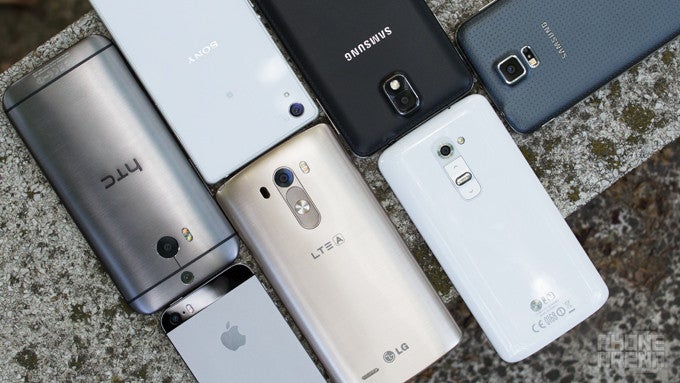
Introduction
We're tech geeks. We're the kind of folks that friends and family consult with prior to buying a new gadget. And when it comes to smartphones, it usually boils down to one thing – the great majority of people who are about to get one want it to take good photos. Surprising? Well, not really. Studies show that taking photos is one of the top uses for a smartphone nowadays. Smartphone manufacturers are well aware of that and put great effort in enabling their devices to take good photos.
The LG G3 is one of the newest contenders on the smartphone scene, and just like the handsets it'll be going against, it comes with a very promising camera. Its 13 megapixels of resolution, 1/3.06” sensor size, and f2.4 aperture don't sound particularly intriguing to anyone who knows their way around a camera, but the improved optical image stabilization (OIS+), dual-tone LED flash, and fast, laser-assisted auto-focus are perks that many of its competitors don't have to offer.
So it is our duty now to put the LG G3's camera to the test – to see how well it performs against other popular high-end models. And for this camera comparison, we've lined up the usual suspects: the Samsung Galaxy S5, the Galaxy Note 3, the iPhone 5s, the LG G2, the Sony Xperia Z2, and the HTC One (M8). Here's a look at what these handsets have to offer in terms of camera specs.

Note: we're using a Panasonic Lumix GH2 as a reference camera.
Colors
Okay, we know it is the LG G3's photos you want us to comment on, so that's what we'll start with. At a glance, the phone performs really well. Its images look fine when viewed on their own, with their bright, colorful presentation. But the thing is that the G3 goes slightly beyond the margins of what we'd consider neutral. The majority of its outdoor images exhibit a warm, yellowish tone, and a slight boost in color saturation is also present. Not bad overall, but the G3 could have performed better.
The cameras on the Samsung Galaxy S5 and the Samsung Galaxy Note 3 appear to be guided by the same set of algorithms, at least when it comes to colors. Their photos are neutral to cold-looking, but relatively accurate in most scenes.
The LG G2 has a higher tendency of skewing colors towards the colder side. Sometimes it nails them well, yet it renders other scenes a tad blueish. It's a hit or miss.
As usual, the iPhone 5s produced warm images with saturated colors during our shoot-out. The extra warmness gives a lively feel to the iPhone's photos, thus making them quite pleasant to look at, but it detaches them from reality somewhat.
This time around, the Sony Xperia Z2 didn't do quite as well as it did in previous comparisons. Some of its shots have a very neutral and accurate color balance, while others exhibit a cold, blueish tone. Some slight color saturation can be seen in the shady areas in some of its photos.
And lastly, the HTC One (M8) can't impress us with its daytime photos. Some do look just fine, but others are greenish in tone, and the purple-hued artifacts seen in others don't make the M8's situation any better.
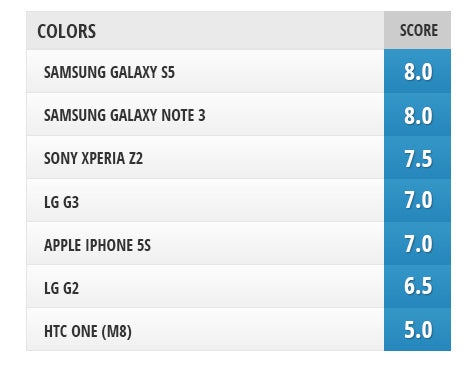
Details
The LG G3 has a 13MP camera, which puts it in a disadvantageous position versus the 16MP Galaxy S5 and the 20.7MP Xperia Z2. But in practice, LG's flagship stands its ground really, really well. Details in its photos are neither too sharp, nor too soft, which gives them a pleasant, natural look even at 100% zoom. What's more, well-lit scenes are very low on digital noise.
The Galaxy S5 takes sharper photos than the G3, although it is clear to see that this sharpness boost comes from the camera's software. As a result, finer details are easier to discern, but edges are rendered sharper than they look in reality. All in all, the S5 and the G3 have their own approaches towards detail preservation, and we won't say that one is better than the other at that.
Similar words can be said about the Samsung Galaxy Note 3 and the LG G2. The former's photos are sharper, while the latter takes photos with softer details. Again, we'd give the two the same score.
As for the Sony Xperia Z2, even its 8MP photos (taken in Intelligent Auto Mode) pack tons of fine detail. We're especially satisfied with its close-up scenes where every blade of grass stands out. The finest of fine detail, however, is somewhat distorted by artifacts.
The iPhone 5s is once again showing us that its 8MP camera produces excellent results. It can't quite outrun the big boys in this category, but given its native resolution, we're very pleased with the results.
And trailing behind the pack is the HTC One (M8) with its 4MP camera. Its photos are usable, but there's a noticeable lack of details in them. The M8's photos are also the ones where digital noise is easiest to spot.
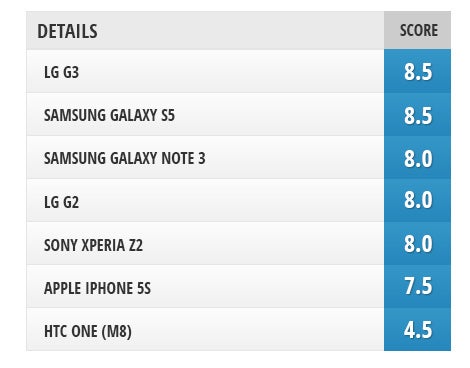
Indoor
So, it turns out that the LG G3 has no troubles with taking photos in a low-light, indoor environment. Details in such images are plentiful, and the digital noise is within the tolerable limits, visible only once we zoom in. Colors are accurate enough even when the LED flash has fired. The dual-tone LED setup is bright and fills the entire frame with light from up to several feet.
This is also a case where the Xperia Z2 performs almost as well as the LG G3. Sony's phone captures details really well and its flash has a very natural tone, despite being of the single-LED kind. The LG G3 outperforms the Z2 only in the darkest scenes with its superior detail preservation.
Then there's the iPhone – an all-around great performer. Again, having just 8MP to work with, it struggles to provide as much detail as, let's say the S5, G3, or the Z2, but nevertheless, we are quite happy with what we see. The iPhone's indoor images look very detailed given the camera's resolution. Color-wise, we do see a boost in warmness and brightness, but in this case, there's nothing too worrying about this. As for the phone's flash, the True Tone LED flash produces warm light that easily lights up the scene, but it fires only in very low lightning situations. Scenes that aren't dark enough to force the flash to fire may end up quite noisy and low on detail. Take a look at our low-light sample in the studio to see what we mean.
Photos from the Samsung Galaxy S5 and the Samsung Galaxy Note 3 have plenty of detail, there's no denying that. Where the two snappers fall short, however, is color accuracy when the flash is in use. Their images are clearly colder than those from the other phones, which renders them somewhat unnatural.
Indoor photos from the LG G2 look quite good, rivaling those from the G3 when it comes to details. But that's valid only as long as there's a good amount of light available. As lights get dim, the presence of digital noise becomes apparent and details also suffer heavily because of that. The G2 has a strong LED light that won't throw color fidelity out the window. It won't fire, however, unless light is really scarce. That's why you might need to force it to fire on certain occasions.
Due to its lower camera resolution, the HTC One (M8) can't provide as much details as the rest of the phones being compared. Color accuracy also leaves lots of room for improvement – colors are dull and lifeless, with a pink-ish hue in darker scenes. On the other hand, the HTC One (M8) took the best-looking photo in complete darkness, with very natural colors and scene filled with light.
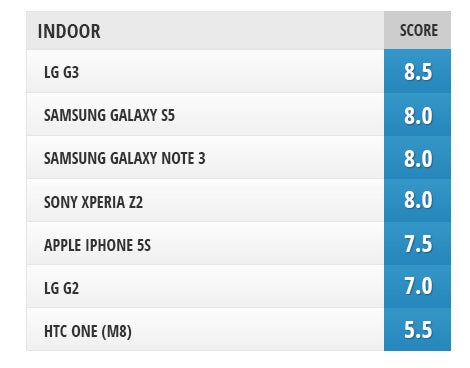
Panorama
The LG G3 does not only takes better photos than its predecessor, the LG G2, but it also outperforms both the Galaxy S5 and the iPhone 5s in this category. Panoramas from the LG G3 are extremely detailed, really well stitched, and of astonishingly high resolution. Our sample below, for example, weighs in at nearly 70 megapixels.
Of course, the Samsung Galaxy S5 and the Samsung Galaxy Note 3 do not lag far behind. Their panoramas, at roughly 60MP each, are chock-full of details and put together with very little stitching imperfections. The iPhone 5s can't reach such high resolution figures – our panorama sample below is weighs in at 26MP – but it makes up for that with a very evenly exposed frame and flawless stitching. Behind it ranks the HTC One (M8) with its average-looking panoramas – they turn out better than what the Xperia Z2 and the LG G2 deliver, but even the iPhone is miles ahead in this category. The Xperia Z2 and the LG G2 take panoramas with very little detail, which renders them next to unusable.

HDR
A single glance is enough to pick a winner in this category – the LG G3. Its HDR shots are very evenly exposed in both light and dark areas, while the overall color balance is retained well. The HDR photos from the Samsung Galaxy S5 and the Samsung Galaxy Note 3 are also very likeable, but at the same time, they are slightly unnatural-looking as a halo is visible between light and dark areas. The iPhone 5s and Sony Xperia Z2 take a different approach. The effect from enabling their HDR modes is very subtle and does not bring as much clarity in shaded areas, but the overall natural look of the scene is preserved well. The LG G2 isn't as capable of an HDR shooter. Enabling the mode often ends up messing up the overall color balance of the image. As for the HTC One (M8), its HDR mode is quite aggressive. The boost in exposure in dark areas is quite strong, and the image looks very unnatural as a result.
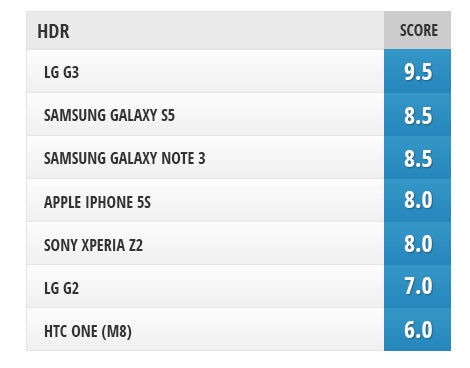
Night
We bring good news, ladies and gents. The LG G3 can be an excellent shooter even at night, taking images with good detail and properly-balanced colors. We must note that we experienced focusing issues on two occasions, but overall, the great majority of its night-time photos turned out splendid.
Not far behind are the Samsung Galaxy S5 and the iPhone 5s. The latter manages to strike a good balance between details and digital noise, all the while capturing colors very accurately. Night photos from the S5 are about as detailed despite the higher resolution of the sensor. Color accuracy is also very good. Overall, the iPhone 5s and the Galaxy S5 perform equally well when shooting night scenes.
The LG G2 and the Sony Xperia Z2 can also capture decent photos at night, but some irregularities become apparent. We noticed that the G2 has a hard time locking the focus in some scenes, and even when the shot is in focus, it might turn out too soft for our liking. The Sony Xperia Z2 tends to mess up the color balance from time to time, adding an unwanted greenish tone to the image. Lastly, the HTC One (M8) takes mediocre night photos. They are okay, of course, but bright objects in them appear as blobs of white light. Noise is also present.
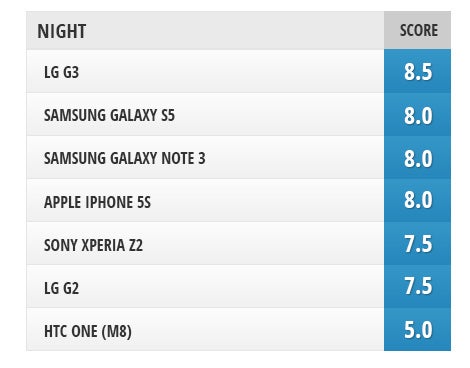
Video
If there's one thing that the LG G3 can't do as well as we wish it could, taking 1080p videos would be it. They are smooth enough and stabilized well by the camera's optical stabilization system, but details aren't as plentiful as they are with the Samsung Galaxy S5 or the Galaxy Note 3, for example. Also, the contrast in videos by the G3 is increased a bit too much. Shooting videos with the G3 at night produces decent results, but some motion blur is apparent. Sound in videos from the LG G3 is mostly loud, but some digital distortion can be heard.
Videos produced by the Samsung Galaxy S5 and the Galaxy Note 3 are noticeably more detailed than the G3's, yet the lack of optical image stabilization is easy to notice. There's digital stabilization, which can be enabled from the settings menu and it works just fine. Sound in their videos is loud and of good quality.
The iPhone 5s, as always, shoots great videos, and the software image stabilization works like a charm. Even at night, Apple's smartphone shoots really fluid and clear footage. The only thing we'd complain about is sound fidelity. For some reason, the 5s records sound of low volume and quality in its videos.
The Sony Xperia Z2 performs well, but we expected to see more. Colors are neutral, footage is smooth, but details aren't as sharp and pronounced like they are in S5's or 5s's videos. Moreover, the software image stabilization does keep the frame very steady, but at the same time, it adds traces of pixelated artifacts around moving objects. Traces of motion blur are seen in the phone's night videos. As for its audio quality, the Z2 captures loud and clear sound in its videos, with a noticeable presence of low-frequency tones.
Good results can be expected from the HTC One (M8) as well. Its videos are smooth and detailed, with neutral colors, quick auto-focus, and excellent sound quality. Night photos are also pleasant to look at, although there's some motion blur noticeable in very low-light scenes.
As for the LG G2, its daytime videos look great, especially when captured at 60fps. The built-in optical stabilization keeps the footage very steady. In low light, however, the G2 can be very unreliable. Even at 30 frames per second, its videos may suffer from heavy motion blur. Sound quality is average. Audio is loud, but heavily digitized.
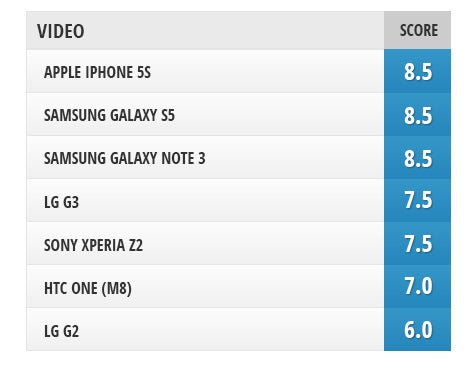
Conclusion
Knowing that the LG G2 had an outstanding camera, we expected nothing short of great results from its successor. And sure enough, the LG G3 did not leave us disappointed with its 13MP camera. The snapper is about as capable as those on the current leaders on the market, such as the Samsung Galaxy S5, the Sony Xperia Z2, and the iPhone 5s. But at the same time, we can't say that the LG G3 is a leader in the pack. Sure, it is a worthy performer, but it is not superior to its Samsung-made rival. Color accuracy is one of the key areas where the G3 could have performed better, and honestly, we were expecting more from it in the video department. On the other hand, we're very pleased with the details in the G3's photos. Its night-time images, panoramas, and HDR shots are also worthy of admiration.
The Samsung Galaxy S5 once again showed us that it is an all-aroung great cameraphone. Its 16MP camera has its flaws, but at the same time, it excelled in most of the scenes that we shot with it. Given enough light, the Galaxy S5 outruns the competition – not by much, but its advantage is still a fact. Just don't expect it to beat the G3 in a night-time shoot-out.
The Samsung Galaxy Note 3 is still standing strong even though it is a model form last year. With its detailed images and videos, it can give even the LG G3 some heated competition. What's more, the Note 3 is an ideal phone for taking 1080p video.
Then we have the iPhone 5s, which demonstrates that 8MP of resolution should be enough for the average consumer's needs. Apple's smartphone is extremely easy to use, all the while enabling us to capture beautiful photos and videos. Color accuracy, however, isn't its strength.
As for the Sony Xperia Z2, it is also a cameraphone that should not be underestimated. Thanks to its 20.7MP camera, it can capture beautiful, detailed photos in a variety of conditions. But stacked up against the LG G3, Sony's flagship phone is a step behind despite its advantage in megapixel count.
The HTC One (M8) ended up last in our comparison for a number of reasons. First and foremost, the UltraPixel approach hurts image detail dramatically, and that's clear to see once you take a look at photos from the M8 and its rivals side by side. Color accuracy also leaves a lot to be desired. At least its videos look presentable.
Oh, and about the LG G2, it may have lost its flagship status, but it is still a capable cameraphone. With 13MP of resolution and optical image stabilization at its disposal, it produces very likeable photos, at least in most cases. Yet its results aren't as consistent as those from the G3. Some images turn out great, while others have their flaws. And at night, don't even bother trying to record a video.
The final score for each phone represents its average rating, but note that we're only taking into account the Details, Color representation and Indoor categories in the final score. We're factoring all the others (such as Night and Panorama) out, since those represent situations where users are less likely to take images in. Video recording isn't included either, since we consider it a separate thing from photo-taking. We've done this in order to end up with a final rating that is representative of a camera's performance in those areas, which we think are most important to users.
Software versions of the smartphone units used in the comparison:
LG G3: Android 4.4.2, build number KVT49L.F400S10e
Samsung Galaxy S5: Android 4.4.2, build number KOT49H.G900FXXU1ANE2
Samsung Galaxy Note 3: Android 4.3, build number JSS15J.N9005XXUBMI7
Apple iPhone 5s: iOS 7.1.1 (11D201)
LG G2: Android 4.2.2, Build number JDQ39B
Sony Xperia Z2: Android 4.4.2, build number 17.1.A.2.55
HTC One (M8): Android 4.4.2, software number 1.54.401.10
You can now read:








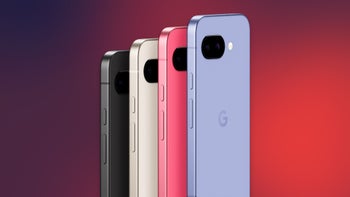
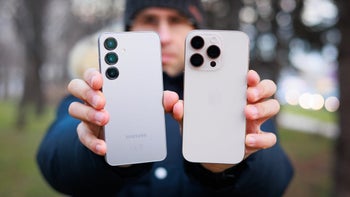

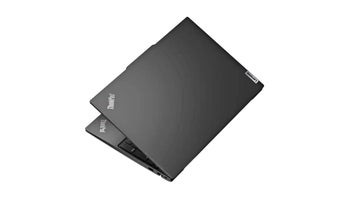






Things that are NOT allowed: